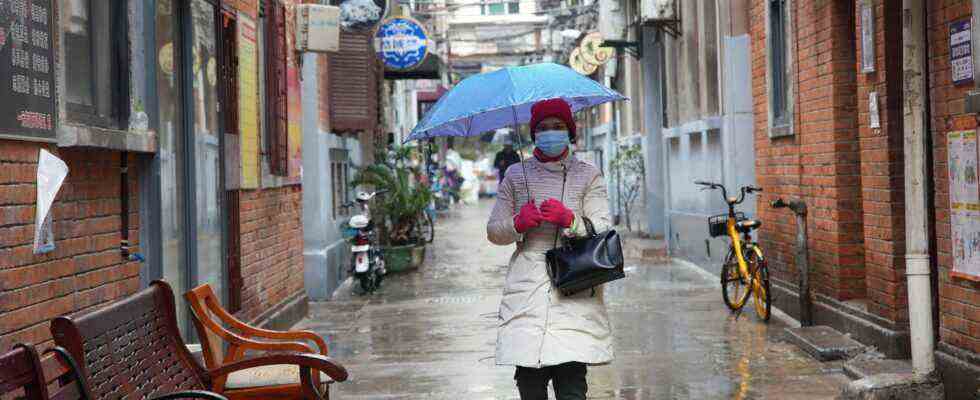Status: 01/24/2022 10:05 a.m
While Omikron is challenging China’s zero-Covid strategy, the crisis is barely noticeable in Wuhan, where it all began two years ago. There they even celebrate the success with a movie.
In Wuhan there is hardly any sign of the Corona crisis. There remains the memory of the lockdown two years ago and collective pride at having banned the virus. And the story of Wuhan is now available as a movie in China. Two years after it all began – after the first outbreak and the first lockdown in Wuhan. Now around 20 people are sitting in front of a screen in a large cinema hall in the metropolis in Hubei Province. It is a heroic epic about the volunteers who helped back then. About those who have been providing food and protective gear to people in lockdown and to doctors.
Yang Qian was one of the volunteers even during lockdown and watched the film. She is proud of Wuhan. And yet she remembers the uncertainty during the lockdown period. She recalls taking a mother and child with Covid symptoms to the hospital on a bike. When they arrived, handwritten notes were hanging on the front door, none of the doctors or nurses could be contacted, everyone was busy.
“We were afraid”
She saw doctors who were desperate and crying. “The doctors tried to save a patient’s life for ten days but they couldn’t revive him and he died. One doctor asked the other what happened and he said he was sorry and he was doing his best did,” she says.
That moment scared her. Also afraid of getting infected. But everything went well for her. Now the artist is processing the lockdown in her paintings and exhibiting them in a gallery in Wuhan. For a year and a half she has been working meticulously on a larger-than-life cityscape of Wuhan. She paints everything in black dots on a white canvas.
The artist Yang Qian processes the lockdown in Wuhan in her paintings.
Image: Eva Lamby-Schmitt
“I’m often asked why I’m painting this picture in black and white and without color. Quite simply: because at that time we were all very lonely and isolated and we were afraid.” Each dot symbolizes a life in Wuhan, she says. All together: strength and solidarity.
An image of the Wuhan city map made up of many small, black dots. Each dot symbolizes a life in Wuhan, says artist Yang Qian. All together: strength and solidarity.
Image: Eva Lamby-Schmitt
anger and many questions
For Zhang Hai from Shenzhen, southern China, the lockdown didn’t end well. He’s not proud. He is angry. His father traveled to Wuhan in Hubei province for an operation in mid-January 2020. He had previously broken his leg. In the hospital in Wuhan, the father is said to have contracted the then new Covid-19 virus and died. Since then, Zhang Hai has been suing the Chinese authorities and claims to have even written a letter to head of state Xi Jinping – without success.
“Why didn’t the governments of Wuhan City and Hubei Province publicize the incident in time and warn everyone to be careful? This disaster is man-made. So many people lost their precious lives in Wuhan.” If he had known about the virus, he would not have gone to Wuhan with his father.
Death numbers in Wuhan corrected drastically
The Chinese city of Wuhan experienced the first lockdown after the outbreak of Covid-19 at the end of January 2020. Most of the corona deaths in China come from these first two and a half months of the pandemic.
According to official figures, China has had 4,636 deaths since the pandemic began. Most of them, almost 4,000, were recorded in the country by the end of the lockdown in Wuhan in April 2020. It is questionable whether the absolute numbers are correct. International observers assume that more people have died. At the beginning of the pandemic, the Chinese authorities had covered up a lot. Only afterwards did China drastically correct the number of deaths in Wuhan.
In the film, the heroes survive
In the movie about Wuhan, the heroes survive. According to China’s narrative: Wuhan as the city of heroes. The virus has been defeated. However, the Delta and Omicron virus variants are currently challenging China’s zero-Covid strategy. Several megacities are completely or partially in lockdown.
Zhang Hai criticizes the Chinese government’s harsh measures: “This shows that they have learned nothing from Wuhan, that many people in the city of Xian did not have enough to eat, that his heavily pregnant wife was not treated in the hospital and that neither were other people were treated and died as a result.”
Olympic Games to be held in “bubble”.
Even if the numbers have officially been going down nationwide since the most recent outbreak: the authorities are particularly tense in the capital Beijing. The Winter Olympics are about a week and a half away. These are to take place in a so-called bubble, shielded from the rest of the country. But the International Olympic Committee has now confirmed: 72 people in the bladder have already tested positive. Two million people are now being tested for the virus in a district of the capital.
Two years after the first lockdown: China between zero-Covid and Omicron
Eva Lamby-Schmitt, ARD Shanghai, 24.1.2022 08:12 a.m

